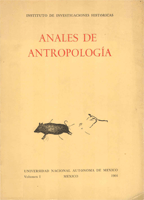Relaciones prehistóricas mediterráneas
Contenido principal del artículo
Resumen
Las relaciones comerciales entre el Mediterráneo occidental en el Egeo y el próximo oriente fueron intensas desde el 3 000 a. C., siendo la intersección entre ambos puntos las islas de Malta, Sicilia y Liparé, con resultados como la introducción de nuevas influencias en la Península Ibérica y un gran auge de culturas cuyos principales recursos comerciales eran el intercambio de metal y cerámica. Dichas relaciones comerciales originaron que muchos de estos centros desarrollaran una civilización monumental como fue el caso de Malta.
Descargas
Los datos de descargas todavía no están disponibles.
Detalles del artículo
Cómo citar
Bosch-Gimpera, P. (2010). Relaciones prehistóricas mediterráneas. Anales De Antropología, 4(1). https://doi.org/10.22201/iia.24486221e.1967.1.17458
Citas en Dimensions Service
Esta revista usa una licencia CC del tipo CC BY-NC-ND 3.0. Se maneja bajo el esquema de acceso abierto, con una licencia Creative Commons Attribution-NonCommercial-NoDerivs 3.0 Unported.

